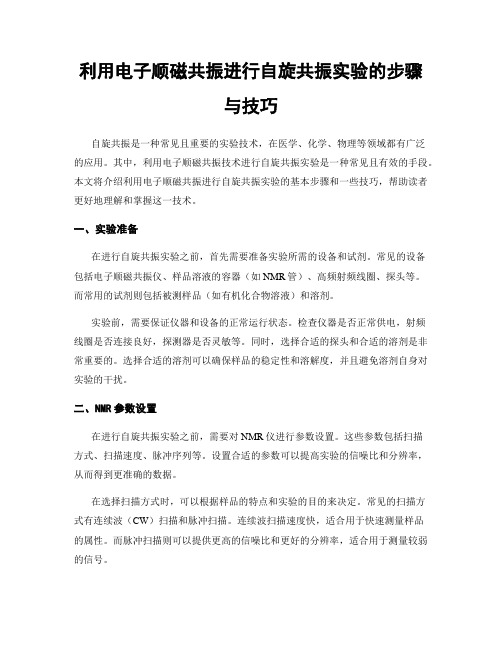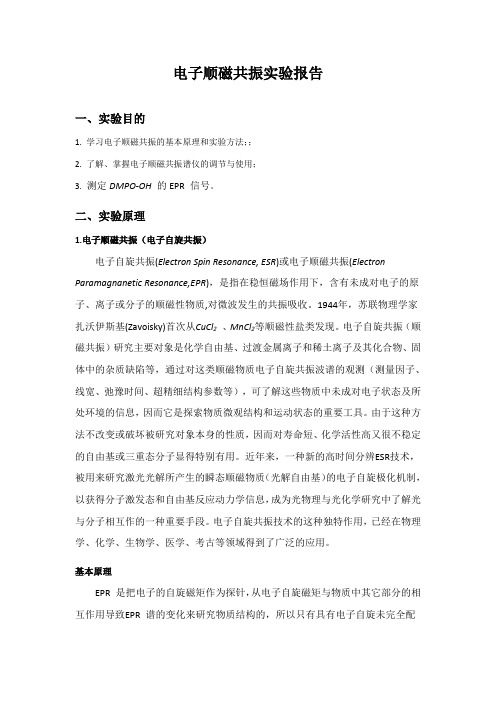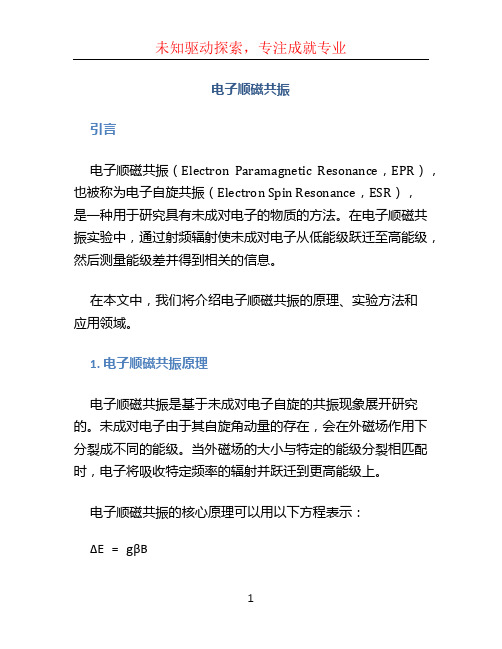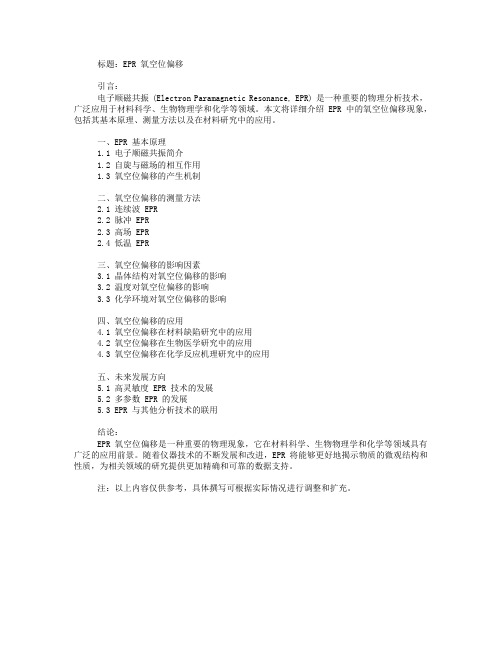电子顺磁共振分析技术1
顺磁共振技术

顺磁共振技术顺磁共振技术(MRI)是一种利用核磁共振原理对人体组织和器官进行成像的检查技术。
它具有无创伤、高分辨率、多平面成像等优点,已成为临床诊断和治疗中不可或缺的重要技术之一。
本文将从MRI的原理、技术优势、临床应用等方面进行详细介绍。
### 一、原理MRI技术基于核磁共振现象,通过在强磁场中对人体组织进行激发和检测核磁共振信号来获取影像。
其基本原理可简单描述为,人体组织中的氢原子在外加强磁场的作用下,会产生共振信号。
这些信号受到射频脉冲的刺激后会发生共振释放,通过梯度磁场的不同设置,使得不同组织的共振信号得以区分,从而形成影像。
### 二、技术优势1. 无创伤: MRI检查不需要对人体进行X射线或其他有害辐射的照射,对患者造成的伤害极小,大大降低了医疗风险。
2. 高分辨率:MRI可以在多个平面上获取高分辨率的影像,从而提供医生更加全面和准确的诊断信息。
3. 多平面成像:MRI可以分别获取横断面、冠状面和矢状面的影像,这些信息有助于医生更加全面地了解病变的性质和位置。
4. 能够区分软组织:MRI对不同的软组织有较好的分辨能力,对脑部、脊椎、胸腹部等组织器官的成像效果较好。
5. 弥散加权成像:MRI可以对水分子的运动进行定量评估,对肿瘤等组织病变的检测等起到辅助作用。
### 三、临床应用1. 脑部疾病诊断:MRI可用于脑卒中、脑肿瘤、脑外伤等疾病的诊断和监测。
2. 脊柱与四肢骨骼成像:MRI可帮助医生诊断脊柱和四肢骨骼的损伤、肿瘤、炎症等情况。
3. 心血管成像:MRI可用于心脏和血管成像,对心血管疾病进行评估和诊断。
4. 腹部和盆腔成像:MRI对肝脏、胰腺、肾脏、子宫等脏器的检测具有较好的效果。
5. 乳腺成像:MRI在乳腺癌筛查和评估中扮演重要角色,尤其对于高风险人群。
### 四、发展前景随着医学影像技术的不断发展,MRI技术也在不断改进。
新一代超高场强MRI系统、功能性MRI和弥散磁共振成像等技术将进一步提高MRI的分辨率、对比度和临床应用价值。
电子顺磁共振谱ESR

谱图解析方法
直接解析法
数据库比对法
通过观察谱线的位置、形状和强度, 结合已知的物质性质和结构信息,直 接解析出被测物质的磁性参数和结构 特征。
将实验谱图与已知的ESR谱图数据库 进行比对,通过相似度匹配来确定被 测物质的类型和结构。
计算机模拟法
利用计算机模拟ESR谱图,通过比较 模拟结果与实验谱图,可以更准确地 解析出被测物质的磁性参数和结构特 征。
应用领域拓展
随着ESR技术的不断发展,其应用领域也在不断拓展,从最初的自由 基研究逐渐拓展到生物医学、环境科学、能源科学等多个领域。
ESR技术面临的挑战
样品制备难度大
由于ESR对样品的纯度和均匀度 要求较高,因此样品制备难度较 大,需要较高的实验技巧和经验。
谱图解析难度高
由于ESR谱图较为复杂,不同组分 的信号容易相互干扰,因此谱图解 析难度较高,需要较高的专业知识 和技术水平。
电子顺磁共振谱(ESR
目录
CONTENTS
• 电子顺磁共振谱(ESR)概述 • ESR实验技术 • ESR谱图解析 • ESR在科学研究中的应用 • ESR技术展望与挑战
01 电子顺磁共振谱(ESR)概述
CHAPTER
ESR定义与原理
定义
电子顺磁共振谱(ESR)是一种研究物质中未成对电子的共振谱技术,通过测量物质在磁场中的电子磁矩变化来 获取物质内部结构和电子状态信息。
选择合适的微波频率,以 避免信号损失和干扰,提 高分辨率。
功率与时间
调整微波功率和曝光时间, 以获得最佳的信号强度和 信噪比。
实验数据处理与分析
数据预处理
对采集到的数据进行滤波、去噪等处理,以提高 信噪比。
参数拟合
电子行业电子顺磁共振

电子行业电子顺磁共振什么是电子顺磁共振(EPR)电子顺磁共振(EPR),也被称为电子自旋共振,是一种重要的分析技术,广泛应用于电子行业。
它基于电子自旋与外加磁场之间的相互作用原理,用于研究物质中未成对电子的状态和环境。
EPR技术在电子行业中有着不可或缺的作用,可以用于研究材料的性质、电子结构以及电子之间的相互作用等方面。
EPR技术在电子行业中的应用1. 材料研究EPR技术在电子材料研究中有广泛的应用。
通过对材料中未成对电子的共振吸收谱进行分析,可以得到关于电子态密度、电子磁矩、自旋-晶格相互作用等物理性质的信息。
这对于电子行业中新材料的设计与开发非常重要。
例如,在磁存储材料的研究中,EPR技术可以用来研究材料中电子自旋的变化,从而改善材料的磁性能。
2. 电子器件设计EPR技术也可以应用于电子器件的设计与制造中。
通过研究电子自旋的行为和相互作用,可以对器件的电子结构进行分析,进而优化器件的性能。
例如,在半导体器件中,通过EPR技术可以研究载流子的自旋,从而提高器件的导电性能和稳定性。
3. 电子结构研究EPR技术在研究电子结构时也起到了重要的作用。
通过测量电子自旋共振信号的强度和形状,可以推断材料中未成对电子的结构信息。
这对于了解材料中电子的分布和行为有着重要意义。
例如,在太阳能电池材料的研究中,EPR技术可以用来研究材料中不同能级的电子结构,从而提高太阳能电池的效率和稳定性。
EPR技术的工作原理EPR技术基于电子自旋与外加磁场之间的相互作用原理。
当样品处于外加磁场中时,电子的自旋会在磁场的作用下发生共振吸收,产生EPR信号。
这个信号可以通过调节磁场的强度和频率来测量,进而得到样品中未成对电子的信息。
EPR技术的优势与局限性优势:•非常灵敏:EPR技术可以检测到样品中极微弱的电子共振信号,使其在分析材料中微量元素的作用、电子结构等方面有着重要作用。
•高分辨率:EPR技术在测量中具有很高的分辨率,可以准确地确定样品中未成对电子的状态和环境。
电子顺磁共振

电子顺磁共振电子顺磁共振是一种重要的物理现象,用于研究电子顺磁能量谱和电子对对称断裂态中的自旋关联现象。
它是一种多体强相互作用的效应,可以被用于研究多体超导态的电子结构,以及量子计算等方面的物理学研究。
电子顺磁共振的基本原理是由于空间梯度的作用,一个磁场能够在电子云中产生一个振荡的场,使得电子能量等级发生改变,从而导致电子的偶极转动和三重态转变,并形成电子顺磁能量谱。
电子顺磁共振实验中,由一定的磁场和温度,使电子云产生振荡,以观察电子谱带结构和混沌分布,并且可以模拟多体强相互作用的稀疏物理效应。
电子顺磁共振实验方法主要包括:用电容式仪器(如透射电子显微镜或透射电子探测器)测量固体中电子对对称断裂态的自旋关联强度;用高磁场量子器件探测器测量高磁场下的电子谱结构变化;以及模拟多体强相互作用的稀疏物理效应,注意观察物理系统的电子结构变化。
近年来,电子顺磁共振技术也被用于研究电子对对称的断裂态的相干性和非平衡态的涨落特性,以及新型多重自旋超导效应。
电子顺磁共振技术还可用于其它方面的研究,如量子计算、分子信息学、生物物理学和精密测量等,都可以从电子顺磁共振实验中获得有价值的信息。
电子顺磁共振技术也作为电子超导态的研究工具,用于研究量子对对称态和磁性结构的调整,以及电子非平衡态的准自旋关联动力学等问题。
电子顺磁共振非常重要,它可以用来研究多体系统、量子计算、分子物理学等物理学问题,也可以用来研究电子顺磁能量谱和电子对对称断裂态中的自旋关联现象。
未来,电子顺磁共振将为许多物理学问题的研究提供有价值的信息,从而更好地进行理论和实验研究。
电子顺磁共振是一种复杂的物理现象,其中的原理和效应是一个持续发展的领域,还有大量的未解决的问题,也有许多未知的物理效应,为后续的研究提供了广阔的发展空间。
《电子顺磁共振》课件

根据样品的属性和需求,选择合适的测量 参数,如磁场强度、射频频率等。
六、实验步骤
1
样品制备
将样品制备成薄片或粉末,保证样品的纯度和适合的形态。
2
设置仪器参数
根据实验要求设置仪器的磁场强度、射频波功率等参数。
3
获取光谱
使用适当的实验方法获取样品的电子顺磁共振光谱。
4
数据处理
对实验得到的数据进行处理和解析,提取有用的谱学信息。
发掘新在更 多领域发挥重要作用。
九、结语
1 总结
电子顺磁共振是一种重要的谱学技术,为材料科学和生命科学研究提供了关键的实验手 段。
2 感谢
感谢各位的聆听和关注,祝愿大家在电子顺磁共振领域有所收获。
3 参考文献
1. Smith, J. Electron Paramagnetic Resonance: Elementary Theory and Practical Applications. Wiley, 2018. 2. Johnson, R. L. Electron Paramagnetic Resonance: Basic Principles and Practical Applications. Springer, 2017.
控制系统
用于控制脉冲导引磁铁和检 测器,调节样品参数和记录 实验数据。
四、实验方法与技术
简介
电子顺磁共振实验方法包括X波段和Q波段等多 种光谱法。
与核磁共振的比较
电子顺磁共振与核磁共振是两种不同的谱学技术, 具有不同的原理和应用领域。
五、样品制备和测量参数的选择
1 样品制备方法
2 选择测量参数
样品制备是电子顺磁共振实验的关键步骤, 包括样品纯化、制备成薄片或粉末等。
电子顺磁共振实验

电子顺磁共振实验实验目的了解微波传输特点、电子顺磁共振实验的实践意义,掌握电子顺磁共振仪的调试方法,观察电子顺磁共振信号。
实验仪器电子顺磁共振仪、示波器 实验原理(1)电子顺磁共振。
电子因绕原子核作轨道运动及自旋运动具有轨道磁矩和自旋磁矩。
具有磁矩的电子在稳恒的外加磁场中具有分立的磁位能。
000B mg B B E B Z μμμ-=-=⋅-=相邻能级间隔为0B g B μ。
当在垂直于恒定外磁场方向加一交变电磁场,其频率为0B g hv B μ=时,具有未成对自旋磁矩的顺磁物质将会出现低能级的电子吸收外加的电磁波跃迁到相邻的高能级的共振吸收现象,此现象即电子顺磁共振。
(详见教材P181~184)(2)仪器原理系统的基本构成如图1。
由微波传输部件把X 波段体效应二极管信号源的微波功率馈给谐振腔内的样品,样品处于恒定磁场中,磁铁由50Hz 交流电对磁场提供扫描,当满足共振条件时输出共振信号,信号由示波器直接检测。
各个微波部件的原理、性能及使用方法如下:图 11、谐振腔:谐振腔由矩形波导组成,A 为谐振腔耦合膜片,B 为可变短路调节器也为短路膜片。
谐振腔的工作原理如下:入射透射图 3设A 膜片反射系数为T ,透射为r ,当处于无损状态时:T r 221+=;B 反射系数为1,样品及传输的损耗为η。
输入幅度为I ,经过膜片反射后初次反射为-IT ,因为反射相位与入射相反,所以为 采用负号;经过A 膜片透射强度Ir ,经过一次反射后达到A 膜片这时电磁场为Ir ⋅ηe i kx 2,经A 膜片部分反射部分透射,反射为Ir e T ikx ⋅⋅-η2,透射为Ir e kx 22⋅η同理得出多次反射后反射强度为:Ir e T e i kx kx n⋅--ηη22() (1) 透射为:Ir e T e kx kx n222ηη() (2)真实反射等于初反射和多次透射的叠加如图(5)。
得:-++--=∑IT Ir eIr e T e ikxikx ikx nn 22222110ηηη() (3)=-++⋅-=-+⋅-----IT Ir eIr eT e T e IT Ir eT e ikxikxi kxikxikx ikx22222222211ηηηηηη (4)当谐振时:eikx-=21得:反射强度为:I I T r T out=⋅-+-()21ηη (5)因为共振信号表现为η的变化,所以我们将(5 )式对η求导得:I I I r T T r T T I T T s out =⋅=--+-=⋅--()()()()()ηηηηηη∆η∆η∆η∆η22222211111 (6)增益K I T T =⋅--1122()η (7) 对T 求最大值得 T =η (8)增益最大值K Q =--=-=11112222ηηη() (9)此时反射强度I I out=-+--=(())ηηηηη1102 (10)Q 为品质因素(Q =-112()η)。
(整理)电子顺磁共振实验讲义

近代物理实验讲义电子顺磁共振南京理工大学物理实验中心2009.1.20电子顺磁共振实验电子自旋共振(Electron Spin Resonance, ESR)又称电子顺磁共振(Electron Paramagnetic Resonance, EPR)。
由于这种共振跃迁只能发生在原子的固有磁矩不为零的顺磁材料中,因此被称为电子顺磁共振;因为分子和固体中的磁矩主要是电子自旋磁矩的贡献所以又被称为电子自旋共振。
1924 年,泡利(Pauli)首先提出了电子自旋的概念。
1944年,前苏联的柴伏依斯基首次观察到了电子顺磁共振现象。
1954 年开始,电子自旋共振逐渐发展成为一项新技术。
电子自旋共振研究的对象是具有未偶电子的物质,如具有奇数个电子的原子、分子以及内电子壳层未被充满的离子,受辐射作用产生的自由基及半导体、金属等。
通过共振谱线的研究,可以获得有关分子、原子及离子中未偶电子的状态及其周围环境方面的信息,从而得到有关物质结构和化学键的信息,故电子自旋共振是一种重要的近代物理实验技术,在物理、化学、生物、医学等领域有广泛的应用。
一.实验目的1.了解电子顺磁共振的原理。
2.掌握FD-TX-ESR-II型电子顺磁共振谱仪的调节和使用方法。
3.利用电子顺磁共振谱仪测量DPPH的g因子。
二.实验原理A 、测量原理原子的磁性来源于原子磁矩,由于原子核的磁矩很小,可以略去不计,所以原子的总磁矩由原子中各电子的轨道磁矩和自旋磁矩所决定。
原子的总磁矩μJ 与总角动量P J 之间满足如下关系:B J J J gP P μμγ=-= (1)式中μB 为玻尔磁子,为约化普朗克常量。
由上式可知,回磁比B gμγ=- (2)其中g 为朗德因子。
对于原子序数较小(满足L -S 耦合)的原子的朗德因子可用下式计算,(1)(1)(1)12(1)J J S S L L g J J +++-+=++ (3) 由此可见,若原子的磁矩完全由电子自旋磁矩贡献(L=0,J=S ),则g=2。
顺磁共振实验报告

摘要:本次实验旨在通过顺磁共振(EPR)技术,探究物质在恒定磁场和射频场或微波场作用下的电子自旋共振现象。
实验中,我们测量了有机自由基DPPH的g因子值,并分析了微波器件在电子自旋共振中的应用。
通过观察矩形谐振长度的变化,我们进一步理解了谐振腔的驻波特性。
实验结果表明,顺磁共振技术在物质结构和性能研究方面具有重要的应用价值。
关键词:顺磁共振,电子自旋共振,DPPH,g因子,谐振腔一、引言顺磁共振(EPR)技术,又称为电子自旋共振(ESR),是一种研究物质电子自旋状态的实验技术。
该技术基于电子自旋在恒定磁场中受到射频场或微波场作用下的磁能级跃迁现象。
顺磁共振技术在物理、化学、生物及医学等领域有着广泛的应用,特别是在研究材料的反应过程、结构和性能方面具有重要作用。
二、实验原理1. 电子自旋与磁矩原子中的电子不仅具有轨道运动,还具有一定的自旋运动。
电子的自旋磁矩与轨道磁矩的合成,决定了原子的总磁矩。
当原子处于外磁场中时,电子自旋会取向磁场方向,产生磁能级分裂。
通过射频场或微波场的作用,电子自旋可以在磁能级之间发生跃迁,从而产生EPR信号。
2. 顺磁共振信号EPR信号具有以下特点:(1)具有明显的吸收峰,峰形尖锐;(2)吸收峰的位置与外磁场强度有关,可用于测量物质的g因子;(3)EPR信号的强度与物质的顺磁性质有关。
三、实验装置与材料1. 实验装置:顺磁共振仪、微波源、射频放大器、探头、计算机等;2. 实验材料:DPPH自由基、样品管、搅拌器等。
四、实验步骤1. 准备样品:将DPPH自由基溶解在适当的溶剂中,配制成一定浓度的溶液;2. 将溶液置于样品管中,置于顺磁共振仪的探头中;3. 设置实验参数:选择合适的磁场强度、射频频率和功率;4. 进行EPR信号采集:启动顺磁共振仪,采集DPPH自由基的EPR信号;5. 分析EPR信号:利用计算机软件对EPR信号进行分析,测量DPPH自由基的g因子值。
五、实验结果与分析1. DPPH自由基的EPR信号实验中,我们成功采集到了DPPH自由基的EPR信号。
《电子顺磁共振》课件

水质监测
通过电子顺磁共振技术可以检测 水体中的重金属离子、有机污染 物等有害物质,为水质监测和治 理提供技术支持。
土壤污染修复
电子顺磁共振技术可以用于土壤 污染修复过程中的自由基监测, 有助于了解土壤污染的修复机制 和效果评估。
05
电子顺磁共振的未来发展与 挑战
技术创新与突破
检测方法的改进
01
提高检测灵敏度、分辨率和稳定性,实现更快速、准确和自动
样品固定
采用适当的固定方法将样 品固定在实验装置中,以 便进行实验操作。
实验操的电子顺磁共振实验装 置。
参数设置
根据实验样品的特点,设置合适的实验参数,如 磁场强度、微波频率等。
实验操作
按照实验步骤进行操作,记录实验数据。
数据处理与分析
数据整理
整理实验获得的数据,确保数据的准确性和完整性。
通过电子顺磁共振技术可以研究催化剂的活性中心和反应过程中电 子结构的改变,有助于优化催化剂的性能。
化学键断裂与形成
电子顺磁共振可以检测化学键的断裂和形成过程中自由基的变化, 有助于理解化学键的本质和化学反应的动力学过程。
在生物学研究中的应用
自由基生物学
电子顺磁共振技术可以用于研究自由基生物学,探索自由 基在生物体内的生成、代谢和作用机制,以及自由基对生 物体的影响。
现状
目前,EPR已经成为一种重要的物理表征手段,广泛应用于 各个学科领域。
应用领域
物理
EPR在物理领域中主要用于研究物质 的电子结构和磁性性质,如铁电体、 超导体等。
生物学
EPR在医学领域中用于研究生物组织 的结构和功能,如肿瘤、心血管疾病 等。
化学
EPR在化学领域中用于研究分子的电 子结构和反应机理,如自由基反应、 化学键断裂等。
电子顺磁共振波谱解析

Lorentz 线型
Y
a 1 bX
2
Gauss 线型 Y aebX 2
1.3.6 g 因子 3400
(1)g因子的概念
但:
9500 2.0023
另外:对于大多数分子,激发态的掺入与取向有关,即 表现为各向异性,从而使 g 因子也是各向异性,则 g 因 子的大小与自旋体系相对于外磁场的方向有关。g 因子 的各向异性通常用一个二级张量形式来描述。
磁矩与磁场相互作用能:
E ˆ Hˆ H cos z H
1.3.3 电子自旋磁矩
❖ 电子自旋磁矩与自旋角动量的关系:
ge 2.0023
e 波尔磁子
2mc
z gM S
其中:M S
1 2
❖ 电子自旋磁矩在外磁场中的能量:
E z H (gM S )H
能级差: E gH
1.3.4 共振条件
第二个氮核进一步发生分裂,
由于作用的强弱与第一个氮核相相同,
所以有部分能级发生重合。
最终产生 5 条谱线,强度比例为: 1:2:3:2:1
如含有:n1 个核自旋为 I1, n2 个核自旋为 I2, : nk 个核自旋为 Ik。
则产生最多(2n1*I1+1) (2n2*I2+1)…(2nk*Ik+1) 条谱线
❖ 久期增宽(Secular Broadening)
Hr H H'
影响H‘的因素:
自旋--自旋相互作用
1. 动态因素 热起伏
2. 空间因素
两个顺磁粒子间的相互作用
~
1 r3
(1
3 c os2
)
增大 r的方法:固体 同晶形 逆磁性 ZnSO4 顺磁性 CuSO4
利用电子顺磁共振进行自旋共振实验的步骤与技巧

利用电子顺磁共振进行自旋共振实验的步骤与技巧自旋共振是一种常见且重要的实验技术,在医学、化学、物理等领域都有广泛的应用。
其中,利用电子顺磁共振技术进行自旋共振实验是一种常见且有效的手段。
本文将介绍利用电子顺磁共振进行自旋共振实验的基本步骤和一些技巧,帮助读者更好地理解和掌握这一技术。
一、实验准备在进行自旋共振实验之前,首先需要准备实验所需的设备和试剂。
常见的设备包括电子顺磁共振仪、样品溶液的容器(如NMR管)、高频射频线圈、探头等。
而常用的试剂则包括被测样品(如有机化合物溶液)和溶剂。
实验前,需要保证仪器和设备的正常运行状态。
检查仪器是否正常供电,射频线圈是否连接良好,探测器是否灵敏等。
同时,选择合适的探头和合适的溶剂是非常重要的。
选择合适的溶剂可以确保样品的稳定性和溶解度,并且避免溶剂自身对实验的干扰。
二、NMR参数设置在进行自旋共振实验之前,需要对NMR仪进行参数设置。
这些参数包括扫描方式、扫描速度、脉冲序列等。
设置合适的参数可以提高实验的信噪比和分辨率,从而得到更准确的数据。
在选择扫描方式时,可以根据样品的特点和实验的目的来决定。
常见的扫描方式有连续波(CW)扫描和脉冲扫描。
连续波扫描速度快,适合用于快速测量样品的属性。
而脉冲扫描则可以提供更高的信噪比和更好的分辨率,适合用于测量较弱的信号。
另外,脉冲序列的选择也十分重要。
不同的脉冲序列可以用于测量不同的参数,如T1、T2等。
在选择脉冲序列时,需要考虑到实验的目的和样品的特点,并进行适当的优化。
此外,还可以对仪器进行自校准,以保证实验的准确性和可重复性。
三、实验操作在进行自旋共振实验时,需要进行一系列的样品处理和操作。
首先,将待测样品溶解于合适的溶剂中,并转移到NMR管中。
注意,在转移过程中需要防止样品受到外界干扰和污染。
然后,将NMR管放置于射频线圈中,并调节线圈的位置和方向,以获得最佳的信号强度。
同时,还需要调节射频场的频率和功率,使得样品与射频场产生共振。
电子顺磁共振-实验报告

电子顺磁共振实验报告一、实验目的1. 学习电子顺磁共振的基本原理和实验方法;;2. 了解、掌握电子顺磁共振谱仪的调节与使用;3.测定DMPO-OH的EPR 信号。
二、实验原理1.电子顺磁共振(电子自旋共振)电子自旋共振(Electron Spin Resonance, ESR)或电子顺磁共振(Electron Paramagnanetic Resonance,EPR),是指在稳恒磁场作用下,含有未成对电子的原子、离子或分子的顺磁性物质,对微波发生的共振吸收。
1944年,苏联物理学家扎沃伊斯基(Zavoisky)首次从CuCl2、MnCl2等顺磁性盐类发现。
电子自旋共振(顺磁共振)研究主要对象是化学自由基、过渡金属离子和稀土离子及其化合物、固体中的杂质缺陷等,通过对这类顺磁物质电子自旋共振波谱的观测(测量因子、线宽、弛豫时间、超精细结构参数等),可了解这些物质中未成对电子状态及所处环境的信息,因而它是探索物质微观结构和运动状态的重要工具。
由于这种方法不改变或破坏被研究对象本身的性质,因而对寿命短、化学活性高又很不稳定的自由基或三重态分子显得特别有用。
近年来,一种新的高时间分辨ESR技术,被用来研究激光光解所产生的瞬态顺磁物质(光解自由基)的电子自旋极化机制,以获得分子激发态和自由基反应动力学信息,成为光物理与光化学研究中了解光与分子相互作的一种重要手段。
电子自旋共振技术的这种独特作用,已经在物理学、化学、生物学、医学、考古等领域得到了广泛的应用。
基本原理EPR 是把电子的自旋磁矩作为探针,从电子自旋磁矩与物质中其它部分的相互作用导致EPR 谱的变化来研究物质结构的,所以只有具有电子自旋未完全配对,电子壳层只被部分填充(即分子轨道中有单个排列的电子或几个平行排列的电子)的物质,才适合作EPR 的研究。
不成对电子有自旋运动,自旋运动产生自旋磁矩, 外加磁场后,自旋磁矩将平行或反平行磁场方向排列。
经典电磁学可知,将磁矩为μ的小磁体放在外磁场H 中,它们的相互作用能为:E=-μ· H = -μH cosθ这里θ为μ与H之间的夹角,当θ= 0 时,E = -μH, 能量最低,体系最稳定。
电子顺磁共振实验报告

电子顺磁共振实验报告电子顺磁共振实验报告引言电子顺磁共振(electron paramagnetic resonance, EPR)是一种重要的物理实验技术,广泛应用于材料科学、生物医学和化学领域。
本实验旨在通过测量电子顺磁共振信号,探索样品的电子结构和磁性特性。
实验原理电子顺磁共振是利用电子自旋与外加磁场相互作用的现象。
当样品中存在未成对电子时,这些电子具有自旋量子数,可以吸收特定频率的微波辐射。
通过改变外加磁场的强度,可以观察到电子顺磁共振信号的变化。
实验中常用的仪器是电子顺磁共振谱仪,它能够提供高灵敏度的测量结果。
实验步骤1. 准备样品:选择适当的样品,如自由基或过渡金属离子溶液。
将样品放置在电子顺磁共振谱仪的样品室中。
2. 设置实验参数:调整磁场强度和微波频率,使其适应样品的特性。
确保磁场均匀性和稳定性。
3. 开始测量:启动电子顺磁共振谱仪,开始记录电子顺磁共振信号。
同时,记录磁场强度和微波频率的变化。
4. 数据处理:根据实验记录的数据,进行信号处理和分析。
可以通过拟合曲线和计算得到样品的电子结构和磁性参数。
实验结果与讨论在实验过程中,我们选择了自由基溶液作为样品进行电子顺磁共振测量。
通过调整磁场强度和微波频率,我们观察到了明显的共振信号。
根据信号的特征,我们可以确定样品中存在未成对电子,这与自由基的性质相符。
进一步分析数据,我们可以得到样品的电子结构和磁性参数。
通过拟合曲线,我们可以确定自由基的g因子和超精细相互作用参数。
这些参数可以提供关于样品分子结构和电子自旋状态的重要信息。
此外,我们还进行了不同条件下的测量,例如改变温度和添加外加剂。
这些实验可以进一步研究样品的磁性特性和相互作用机制。
通过比较不同条件下的电子顺磁共振谱图,我们可以得到更全面的结论。
结论通过电子顺磁共振实验,我们成功地测量了自由基溶液的电子顺磁共振信号,并获得了样品的电子结构和磁性参数。
这些结果对于理解材料的磁性行为和生物体内的自由基反应机制具有重要意义。
epr的工作原理 -回复

epr的工作原理-回复epr(电子顺磁共振)是一种强大的分析技术,广泛应用于化学、物理学、生物学和材料科学等领域。
它通过测量物质中未成对电子的行为,提供了关于物质结构和特性的宝贵信息。
本文将详细介绍epr的工作原理,从基础概念到仪器设备的运作,一步一步解释。
1. 电子顺磁共振的基本概念电子顺磁共振是一种类似于核磁共振的技术。
原子或分子中未成对电子具有自旋属性,就像地球自转一样。
这些未成对电子的自旋会与磁场相互作用,从而形成共振现象。
epr利用这种原理测量物质中未成对电子的行为,从而了解物质的特性和结构。
2. 电子顺磁共振的仪器设备电子顺磁共振仪器一般由四个主要部分组成:微波源、磁场系统、探测器和数据处理系统。
微波源产生既定频率的微波信号,磁场系统提供稳定的磁场使未成对电子发生共振,探测器接收并测量共振信号,数据处理系统用于处理和分析测量结果。
3. 磁场系统的工作原理磁场是电子顺磁共振的重要参数,它对共振现象的发生和测量结果有着显著影响。
磁场系统通常由永磁体或电磁体构成,用于产生稳定的恒定磁场。
在电子顺磁共振中,磁场的强度通常在几百到几千高斯之间,以使电子发生共振。
4. 激发和检测共振信号微波源产生的微波信号与磁场系统中的恒定磁场相互作用,使未成对电子的自旋状态发生变化。
当微波信号的频率与未成对电子的共振频率匹配时,未成对电子将吸收微波能量,从低能级跃迁到高能级。
这种跃迁会导致共振信号的出现。
探测器用于接收共振信号,并将其转换为电信号。
常用的探测器包括磁场调制器和检测线圈。
磁场调制器会引起微弱的磁场调制,使共振信号在时间上发生周期性变化,增强信号的检测灵敏度。
检测线圈负责接收信号,并将其转化为电压信号。
5. 数据处理和分析测量到的电压信号经过放大和滤波等处理之后,将被传送给数据处理系统。
数据处理系统通过数学算法和计算技术对测量信号进行分析和处理,提取出有用的信息。
这些信息包括共振信号的强度、峰位、形状等,从而推断出物质的特性和结构。
化学分析中的电子顺磁共振技术

化学分析中的电子顺磁共振技术电子顺磁共振技术(Electron Paramagnetic Resonance,EPR),又称电子自旋共振技术(Electron Spin Resonance,ESR),是一种常用于化学分析的技术之一。
它适用于金属离子或自由基等的研究,对于生物、物理、无机等多个领域都有应用。
其中,化学应用领域最为广泛,因为它可以进行定量的电子自旋耦合分析,数学上也可以解释分子中的电荷分布等本质性质。
一、技术原理EPR技术是基于电子自旋的原理,电子有电荷和自旋两个基本属性,自旋是电子物质特有的独立运动,它的存在使得电子变得具有磁矩。
当电子处于磁场的作用下,电子的自旋会发生跃迁,导致分子中的电子能级分布发生变化,从而产生光谱信号,通过光谱信号反映分子的结构和本质性质。
典型的EPR实验中,样品通常是放置于一个磁场中,由于电子共振,机器可以检测到这些电子的能量变化;调节磁场的强度和方向,可以扫描样品,得到EPR光谱。
通过解析光谱,我们可以了解分子的自由基、金属离子及其他电子顺磁离子等之间的电子自旋耦合性,从而了解分子的性质。
二、应用案例氧缺失二氧化钛(TiO2-x)纳米颗粒是一种有潜力的和谐光电材料。
微观上,这种材料由于缺氧,其纳米颗粒表面会存在一些自由基,从而使得其光电性质变得更加复杂。
研究人员通过EPR技术对这些自由基进行研究,发现其中一种自由基有望用于制备更加高效的光电探测器。
在虫草菌中,生长孢子过程中,孢子的表面含有大量的锰离子。
研究人员们使用EPR技术研究了其孢子表面的锰离子离子键,在锰离子形成离子键的同时,还能够稳定其孢子的细胞壁,从而形成一个完整的孢子。
这为虫草菌繁殖和感染寄主提供了新的理解和应用。
三、技术的优势EPR技术相对于传统的光谱技术,具有一系列的优势,主要包括:1. 选择性:利用EPR技术,可以在样品中检测到只含有未成对(也叫自由)的电子的分子。
2. 灵活性:该技术的扫描范围相对于其他技术较大,可以用于研究低分子量物质、原子尺度上的分子以及大分子等。
电子顺磁共振

电子顺磁共振引言电子顺磁共振(Electron Paramagnetic Resonance,EPR),也被称为电子自旋共振(Electron Spin Resonance,ESR),是一种用于研究具有未成对电子的物质的方法。
在电子顺磁共振实验中,通过射频辐射使未成对电子从低能级跃迁至高能级,然后测量能级差并得到相关的信息。
在本文中,我们将介绍电子顺磁共振的原理、实验方法和应用领域。
1. 电子顺磁共振原理电子顺磁共振是基于未成对电子自旋的共振现象展开研究的。
未成对电子由于其自旋角动量的存在,会在外磁场作用下分裂成不同的能级。
当外磁场的大小与特定的能级分裂相匹配时,电子将吸收特定频率的辐射并跃迁到更高能级上。
电子顺磁共振的核心原理可以用以下方程表示:ΔE = gβB其中,ΔE代表能级差,g为电子的旋磁比,β为普朗克常量,B为外磁场的大小。
2. 电子顺磁共振实验2.1 仪器设备进行电子顺磁共振实验通常需要以下仪器设备:•电子顺磁共振仪:用于产生恒定的外磁场,并进行射频辐射的发射和接收。
•射频源:用于产生射频辐射。
•微波源:用于产生微波辐射。
•探头:用于与样品接触,将样品放入恒定外磁场中。
2.2 实验步骤电子顺磁共振实验的基本步骤如下:1.准备样品:选择合适的样品进行实验,并将样品放入探头中。
2.确定外磁场:通过调节电子顺磁共振仪中的磁场强度,使其满足能级分裂的共振条件。
3.辐射射频和微波:在满足共振条件的磁场下,分别辐射射频和微波进行激发。
4.记录数据:测量射频和微波辐射的频率以及相应的共振信号强度,记录实验数据。
5.数据处理:对实验数据进行处理和分析,提取出所需的信息和参数。
3. 电子顺磁共振的应用电子顺磁共振广泛应用于物理学、化学和生物学等领域,主要用于以下方面:3.1 材料科学电子顺磁共振可以通过研究材料中的未成对电子状态及其相互作用来了解材料的结构和性质。
它被广泛应用于材料科学中的磁性材料、光纤材料等的研究中,为材料的开发提供了重要的参考。
EPR技术在化学分析中的应用

EPR技术在化学分析中的应用电子顺磁共振(Electron Paramagnetic Resonance,EPR)技术是一种非常优秀的技术,在化学分析中有着广泛的应用。
除了物理和生物学领域中的研究外,EPR技术同样被一个越来越多的化学家所借助,用于定量和定性表征有机和无机物质,同时还在环境化学和食品科学中广泛使用。
一般来说,EPR技术通过测量待分析样品产生的电子的微波辐射信号来进行分析。
待测样品的特定属性影响到电子的辐射,使它有一个独特的谱,从而提供有关样品的信息。
这种技术广泛应用在研究化学反应动力学,分析电子的传输和催化。
在接下来的段落中,我们将深入了解EPR技术在化学分析中的应用。
定性分析EPR是分析某些物质的性质时一种重要的方法,通过测量辐射的谱线给出物质的自由基或金属离子的参数。
简单来说,自由基是分子内存在未成对电子的剩余电子。
通过EPR技术,我们可以非常容易地检测到自由基并定量表征它们。
自由基在化学反应中有着广泛的应用,例如在辐射损伤修复机制、发动机和涡轮机的燃烧中等。
此外,金属的离子也可以借助EPR技术进行定性分析。
金属离子对于化学反应过程至关重要。
使用EPR技术,金属离子可以被直接测量到,从而获得如氧化还原状态、配位化学、磁性等信息。
这对于合成金属配合物、研究金属催化反应或者了解生物体中的金属离子也有很大的帮助。
定量分析EPR技术在定量分析中同样拥有重要作用。
对于某些光敏和放射性物质而言,使用传统的化学检测技术是不可能的,因为它们会破坏样品。
而通过利用EPR技术可以避免这种情况,从而进行更精确的定量分析。
此外,EPR也可以在催化和电化学反应定量分析中应用。
比如,在电化学反应中,EPR技术可以帮助确定催化剂中的金属离子的浓度和配位环境。
这对于催化剂的性能和催化反应机理的研究都有非常重要的意义。
研究氧化还原反应机理EPR技术在研究氧化还原反应机理中也有着广泛的应用。
化学反应过程中的氧化还原过程是非常重要的。
电子顺磁共振(ESR)教程

3、浓度控制,浓度过大或过小都会对样品信号造成干
扰,导致精细结构看不到,因此选择适当的浓度会对
测试提供帮助。
2021/10/10
11
未除氧
除氧
2021/10/10
12
浓度的影响
2021/10/10
13
溶液运动的影响
2021/10/10
14
3、固体样品
固体样品制备过程中需要注意颗粒大小,粉末样品也 需要注意顺磁浓度,浓度太大的话会对信号造成干扰 ,固体样品如果浓度太大可以采用固体稀释方法,使 用干燥的硅胶或者碳酸钙等都能起到稀释的作用。
2021/10/10
10
液体样品的制备
在ESR测试中,常见的是液体样品的测试,如自由基 ,有机反应中间体,过渡金属等,液体样品制备过程 中需要注意以下几点:
1、溶剂。测量液体样品时,要注意溶剂的极性,对于 极性大的溶剂,需要将样品放在毛细管中进行测试, 以避免溶剂对微波的吸收。
2、除氧。液体样品中氧气对信号的干扰非常大,需要 对样品进行通氮或真空除氧,以保证测试过程中能看 到精细的机构信息。
2021/10/10
2
How does EPR work? DE = gb H
DE
hn
Energy
microwave source
2021/10/10
gbH0 = hn
H1
H0
H2
External magnetic field 3
电子顺磁共振
在垂直于B0的方向上施加频率为hn的电 磁波,当满足hn =g b B0 时,处于两能级 间的电子发生受激跃迁,导致部分处于 低能级中的电子吸收电磁波的能量跃迁 到高能级中,这就是顺磁共振现象。受 激跃迁产生的吸收信号经电子学系统处 理可得到EPR吸谱线。 (g 因子, g e =2.0023; b波尔磁子)
epr 氧空位 偏移

标题:EPR 氧空位偏移
引言:
电子顺磁共振(Electron Paramagnetic Resonance, EPR) 是一种重要的物理分析技术,广泛应用于材料科学、生物物理学和化学等领域。
本文将详细介绍 EPR 中的氧空位偏移现象,包括其基本原理、测量方法以及在材料研究中的应用。
一、EPR 基本原理
1.1 电子顺磁共振简介
1.2 自旋与磁场的相互作用
1.3 氧空位偏移的产生机制
二、氧空位偏移的测量方法
2.1 连续波 EPR
2.2 脉冲 EPR
2.3 高场 EPR
2.4 低温 EPR
三、氧空位偏移的影响因素
3.1 晶体结构对氧空位偏移的影响
3.2 温度对氧空位偏移的影响
3.3 化学环境对氧空位偏移的影响
四、氧空位偏移的应用
4.1 氧空位偏移在材料缺陷研究中的应用
4.2 氧空位偏移在生物医学研究中的应用
4.3 氧空位偏移在化学反应机理研究中的应用
五、未来发展方向
5.1 高灵敏度 EPR 技术的发展
5.2 多参数 EPR 的发展
5.3 EPR 与其他分析技术的联用
结论:
EPR 氧空位偏移是一种重要的物理现象,它在材料科学、生物物理学和化学等领域具有广泛的应用前景。
随着仪器技术的不断发展和改进,EPR 将能够更好地揭示物质的微观结构和性质,为相关领域的研究提供更加精确和可靠的数据支持。
注:以上内容仅供参考,具体撰写可根据实际情况进行调整和扩充。
- 1、下载文档前请自行甄别文档内容的完整性,平台不提供额外的编辑、内容补充、找答案等附加服务。
- 2、"仅部分预览"的文档,不可在线预览部分如存在完整性等问题,可反馈申请退款(可完整预览的文档不适用该条件!)。
- 3、如文档侵犯您的权益,请联系客服反馈,我们会尽快为您处理(人工客服工作时间:9:00-18:30)。
电子顺磁共振(EPR)概论 或电子自旋共振(ESR)概论
陈 家 富
合肥微尺度物质科学国家实验室 顺磁共振室
二00六年十月
阅读参考书:
2006研究生课程— EPR
1、范康年主编,谱学导论,高教出版社 ,2001 2、裘祖文,电子自旋共振波谱,科学出版社, 1980 3、张建中等,自旋标记ESR波谱的基本理论和应 用,科学出版社 ,1987 4、陈贤镕,电子自旋共振实验技术,科学出版社 ,
EPR—研究对象三
分子轨道理论可以解释。如:O2分子:
2O [(1S)2 (2S)2 (2P)4] O2 [KK(σ2s)2(σ*2s)2(σ2p)2(πy2p)2(πz2p)2(πy*2p)1(πz*2p)1]
—— 三重态分子
这类化合物分子轨道上也有两个未偶电子,但其与双基 不同,这两个电子彼此相距很近,有很强的相互作用。有两类: 1、激发三重态;如:萘激发三重态;
EPR—研究对象三
PBN-OH加合物的ESR谱线:
EPR—研究对象三
化妆品:如SOD,抗氧剂(防晒油等);
烟草:清除烟草烟气自由基—有害成分; 如何提香、降害?—烟草制品的改进方向。
—— 双基或多基
这类化合物含有两个或两个以上未成对电
子,且它们相距甚远,相互作用也很弱。
EPR—研究对象三
例如: Ph2C
四、 电子顺磁共振仪
EPR—研究对象三
一、 电子顺磁共振的研究对象
Application Fields of ESR Spectroscopy
Magnetic substance photo-translation Transition metal ion Catalyst Metal complex Teeth, Bone Shell, Coral Radiation defects Coal, Oil Erosion Spin label Fluidity SOD activity Aging, Cancer Co-enzyme Vitamin C, E, K Combustion Spin trap Active oxygen Enzyme
EPR—研究对象三
Glass-fiber
Ionomer Conducting polymer Degradation Polymerization
Quartz, Aging
Liquid crystal LB membrane Organomagnetic Conducting materials
Immunoassay Drug detection
Raymond snubbed by Nobel Committee because he is beloved by God? Godless science shits on a saint.
I don't know. Perhaps Raymond deserves the prize. MRI was first attempted by him but his results were pretty much useless. His original paper has been discredited by follow up research. I personally see no conflict between science and spiritualism, but putting a Christian God as the head of the universe is tacky in my opinion. Teaching that there has been no evolution, that Genesis contains a literal cosmology, well that isn't science in any sense I understand.
EPR—研究对象三
再如:蒽分子它本身是逆磁性分子
An + K (真空无水条件)
An- + K+ (用四氢呋喃作溶剂)
An + H2SO4 (98%)
An+
EPR—研究对象三
其它相关的自由基化学:
EPR—研究对象三
EPR—研究对象三
EPR—研究对象三
EPR—研究对象三
EPR—研究对象三
酒类:啤酒主要性能指标之一,lag time Beer-Flavor Stability
Now the controversy is Was
I'll let God decide whether Raymond gets his Nobel or not…..
2006研究生课程— EPR
本课程主要内容:
一、 电子顺磁共振的研究对象 二、 电子顺磁共振的基本原理 三、 电子顺磁共振波谱
2、基态就是三重态分子如:氧分子。
—— 过渡金属和稀土元素
EPR—研究对象三
EPR—研究对象三
过渡金属、稀土元素具有未充满的3d,4d,5d及 4f壳层,核外有一个或一个以上的未成对电子。
V23(4S23d3) V5+(3d 0)无EPR信号 V4+(3d 1)有EPR信号 Mn25(4S23d5) Mn5+ (3d 0)无EPR信号 Mn2+ (3d 5)有EPR信号
EPR—研究对象三
—— 固体碱金属 碱金属的核外价电子:nS1 —— 自由基(radical) 含有一个未成对电子的化合物。
如:· CH3,SP3杂化;
EPR—研究对象三
二苯基苦基肼基(DPPH) Diphenyl Picryl Hydrazyl
Ph Ph NO 2 N N NO 2 NO 2
DPPH的ESR谱线:
2002年
K. Wü thrich
2003年
P.C. Lauterbur,
S. P. Mansfield (到今年为止)
Nobody loves Raymond (Damadian)
The Nobel Prize in Medicine did NOT go to Raymond Damadian, and he is mad as hell. Mad enough to take out advertisements in the NY Times and the Washington Post. ……. (the way it is still done today). Raymond wasn't detoured he thinks outside the box. So he did some experimentation gathered up a set of data and published a nice bit of original work. He still didn't have a machine that we would call a modern MRI. The data his machine produced was not a pretty picture, nor could his results and conclusions be verified. But he did publish that paper. It got others thinking and involved with MRI. Other people who actually produced practical working MRI devices. Our boy Ray couldn't get his machine to work very well, for years he couldn't. He did however get a patent. With that patent he spent years chasing GE Medical Systems through the courts. He and his lawyers got over $100 million dollars from them in the end. His company eventually did produce an MRI device that could be sold on the market. My title is misleading there is a group of individuals who love Raymond. It is the Creation Science community.
C Ph2
两个碳上各有一个未偶电子,且被两个苯环隔开,相
互作用很弱,是一个典型的双基,可以用 EPR研究它。
—— 顺磁性分子(含有未成对电子 的分子)
如:NO,NO2,O2等分子,本身就具有未
成对电子,是顺磁性的。
EPR—研究对象三
g, X-ray, UV
EPR—研究对象三
Stable Free Radicals in Gas Phase
called ESR, Electron Spin Resonance, ESR.
2006研究生课程— EPR
因磁共振的杰出贡献而获得诺贝尔奖科学家
1944年 I.S. Rabi 1952年 F. Bloch, E.M.
Purcell
1955年 1966年 1981年 1989年 W.E. Lamb, P. Kusch A. Kastler N. Bloembergen N.F. Ramsey 1964年 1977年 1983年 1991年 C.H. Townes J.H. Van Vleck H. Taube R.R. Ernst
1986
5、石津和彦 等,实用电子自旋共振简明教程(生
